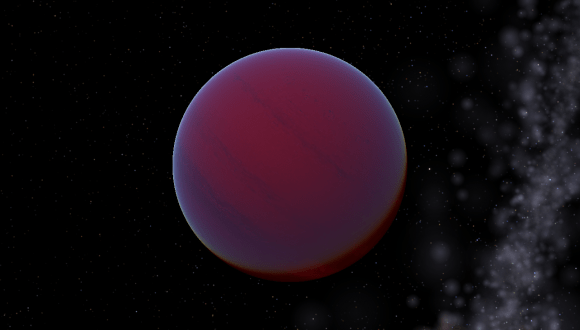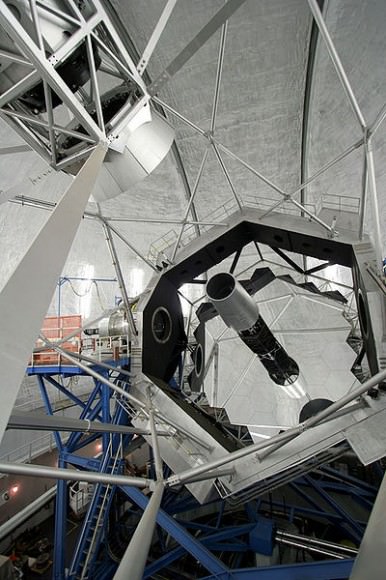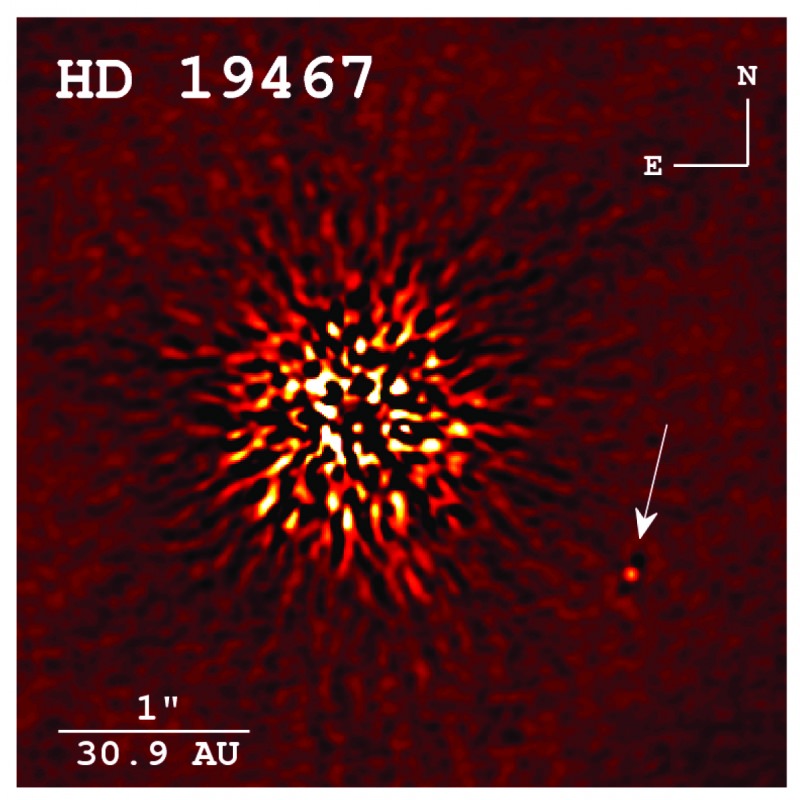A recent find announced by astronomers may go a long ways towards understanding a crucial “missing link” between planets and stars.
The team, led by Friemann Assistant Professor of Physics at the University of Notre Dame’s Justin R. Crepp, recently released an image of a brown dwarf companion to a star 98 light years or 30 parsecs distant. This discovery marks the first time that a T-dwarf orbiting a Sun-like star with known radial velocity acceleration measurement has been directly imaged.
Located in the constellation Eridanus, the object weighs in at about 52 Jupiter masses, and orbits a 0.95 Sol mass star 51 Astronomical Units (AUs) distant once every 320-1900 years. Note that this wide discrepancy stems from the fact that even though we’ve been following the object for some 17 years since 1996, we’ve yet to ascertain whether we’ve caught it near apastron or periastron yet: we just haven’t been watching it long enough.
The T-dwarf, known as HD 19467 B, may become a benchmark in the study of sub-stellar mass objects that span the often murky bridge between true stars shining via nuclear fusion and ordinary high mass planets.
Brown dwarfs are classified as spectral classes M, L, T, and Y and are generally quoted as having a mass of between 13 to 80 Jupiters. Brown dwarfs utilize a portion of the proton-proton chain fusion reaction to create energy, known as deuterium burning. Low mass red dwarf stars have a mass range of 80 to 628 Jupiters or 0.75% to 60% the mass of our Sun. The Sun has just over 1,000 times Jupiter’s mass.
Researchers used data from the TaRgeting bENchmark-objects with Doppler Spectroscopy (TRENDS) high-contrast imaging survey, and backed it up with more precise measurements courtesy of the Keck observatory’s High-Resolution Echelle Spectrometer or HIRES instrument.

TRENDS uses adaptive optics, which relies on precise flexing the telescope mirror several thousands of times a second to compensate for the blurring effects of the atmosphere. Brown dwarfs shine mainly in the infrared, and objects such as HD 19467 B are hard to discern due to their close proximity to their host star. In this particular instance, for example, HD 19467 B was over 10,000 times fainter than its primary star, and located only a little over an arc second away.
“This object is old and cold and will ultimately garner much attention as one of the most well-studied and scrutinized brown dwarfs detected to date,” Crepp said in a recent Keck observatory press release. “With continued follow-up observations, we can use it as a laboratory to test theoretical atmospheric models. Eventually we want to directly image and acquire the spectrum of Earth-like planets. Then, from the spectrum, we should be able to tell what the planet is made of, what its mass is, radius, age, etc… basically all of its relevant properties.
Discovery of an Earth-sized exoplanet orbiting in a star’s habitable zone is currently the “holy grail” of exoplanet science. Direct observation also allows us to pin down those key factors, as well as obtain a spectrum of an exoplanet, where detection techniques such as radial velocity analysis only allow us to peg an upper mass limit on the unseen companion object.
This also means that several exoplanet candidates in the current tally of 1074 known worlds beyond our solar system also push into the lower end of the mass limit for substellar objects, and may in fact be low mass brown dwarfs as well.
Another key player in the discovery was the Near-Infrared Camera (second generation) or NIRC2. This camera works in concert with the adaptive optics system on the Keck II telescope to achieve images in the near infrared with a better resolution than Hubble at optical wavelengths, perfect for brown dwarf hunting. NIRC2 is most well known for its analysis of stellar regions near the supermassive black hole at the core of our galaxy, and has obtained some outstanding images of objects in our solar system as well.

What is the significance of the find? Free floating “rogue” brown dwarfs have been directly imaged before, such as the pair named WISE J104915.57-531906 which are 6.5 light years distant and were spotted last year. A lone 6.5 Jupiter mass exoplanet PSO J318.5-22 was also found last year by the PanSTARRS survey searching for brown dwarfs.
“This is the first directly imaged T-dwarf (very cold brown dwarf) for which we have dynamical information independent of its brightness and spectrum,” team lead researcher Justin Crepp told Universe Today.
Analysis of brown dwarfs is significant to exoplanet science as well.
“They serve as an essential link between our understanding of stars and planets,” Mr. Crepp said. “The colder, the better.”
And just as there has been a controversy over the past decade concerning “planethood” at the low end of the mass scale, we could easily see the debate applied to the higher end range, as objects are discovered that blur the line… perhaps, by the 23rd century, we’ll finally have a Star Trek-esque classifications scheme in place so that we can make statements such as “Captain, we’ve entered orbit around an M-class planet…”
Something that’s always been fascinating in terms of red and brown dwarf stars is also the possibility that a solitary brown dwarf closer to our solar system than Alpha Centauri could have thus far escaped detection. And no, Nibiru conspiracy theorists need not apply. Mr. Crepp notes that while possible, such an object is unlikely to have escaped detection by infrared surveys such as WISE. But what a discovery that’d be!

